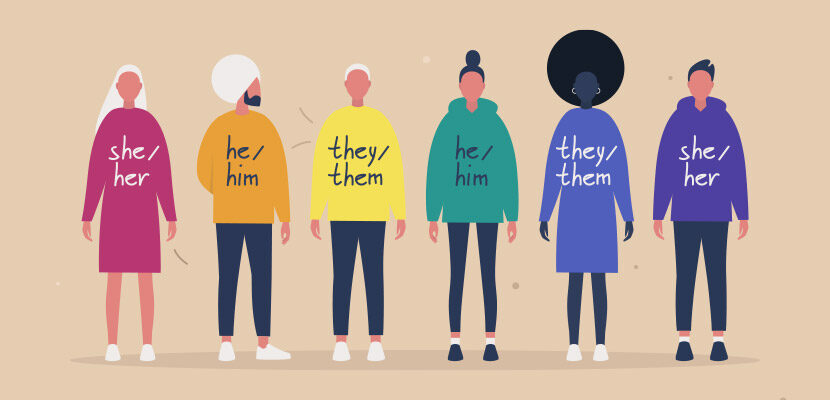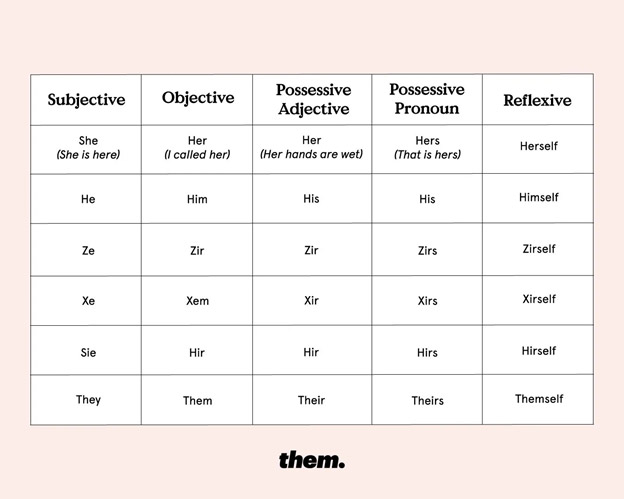
Photo Credit: iStock.com/nadia_bormotova
Employees with varied gender identities are entering our workplaces and it is the need of the hour to make sure we create an inclusive, diverse, and equitable environment for them. This not only creates brands that are loved and respected by the audience but also enables places where employees feel safe and seen.
One way to do that is to facilitate conversations about people’s gender pronouns.
For gender nonconforming and trans individuals, gender pronouns are critically important. They not only make a person feel seen and heard, but also create safe spaces for everyone in the workplace.
If you are determined to cultivate an empathic and inclusive work environment in your own company, it is extremely important to empower people to talk about their gender pronouns.
The work starts by understanding what gender pronouns are.
When we talk about people without using their name, we use their pronouns, without even thinking about it.

In the prevalent culture of cisnormativity, pronouns are sorted into two strict categories: male and female. If your gender is male, you use male pronouns i.e., he/him/his. For females, the typical pronouns are she/her/hers.
But the notion of gender and gender pronouns is more fluid and more personal. To create an inclusive workspace, it is highly discouraged to assume people’s pronouns based on how they look, behave, or dress (aka gender expression).
It is more respectful, and also common sense, to let people tell us what their personal gender pronouns (PGPs) are.
Familiarize yourself with some of the most popular and commonly used pronouns that transgender and non-binary people use for themselves.
Remember not to attribute they/them pronouns to every gender-fluid person you meet. Always ask them. And use the pronouns they share.

Image Source: Gender-neutral pronoun table by them
Calling people by their names and correct pronouns is just simply basic good manners. You wouldn’t want people to use names for you that aren’t yours. By using the right pronouns for everyone in the office, you extend a simple, basic courtesy to them and forge an environment of respect and acceptance.
When you address people with their right pronouns, you tell them that you see them, accept who they are, and are willing to learn and make changes to create a positive and supportive work environment for them.
Know that when a person feels comfortable enough to share their pronouns with you, it has taken them a lot of work to arrive at this point. There is an element of risk too that they are taking in the moment. So, when you accidentally misgender them, you create an environment of mistrust and unease. Using people’s right pronouns is vital for your employees’ mental health and wellbeing.
When you accidentally misgender someone, immediately correct yourself and address your colleague with more respect, and with the correct pronouns.
Using non-binary gender pronouns will take time and work to become a normal part of your everyday interactions. Mistakes will happen and slip ups will occur. When that happens, don’t dwell on it and make it the responsibility of the wronged person to make you feel better.
Accept your mistake, correct it, and move on. Learn to be better in the future, and invest the time and effort into continuing to learn and making your interactions more gender-neutral.
While it is absolutely vital to make your workspaces supportive of conversations about gender pronouns, there is harm in forcing people to share what pronouns they use for themselves.
To indicate to your workforce that you encourage these conversations, you can always start by sharing your own pronouns in the meetings or adding them to your digital signature. When others see these visible signs of workplace inclusion, they may feel more confident becoming a part of that practice.
But turning it into a company policy may go against the best practices of inclusion.
A person’s pronouns are personal. They may not feel ready to share theirs yet, or at all in the workplace. Some trans or nonbinary people do not use any pronouns at all and prefer simply to be called by their names. It is also common for gender nonconforming people to switch between pronouns as their gender identities are more fluid.
Therefore, it’s best to foster inclusive workplaces where people feel safe and seen, and not bind it with rules enforcing people to share views they are not comfortable doing.
It’s best to start by introducing your own pronouns to indicate to others that it’s a safe space to do so, if they choose. Then, keep the question straightforward, clear, and casual.
A few real-life work scenarios where such a conversation can take place include:
Before you hire your first trans or nonbinary employee, use your recruitment process as a place to set the tone for inclusion. In all the forms to fill add spaces where people can include their pronouns or titles such as Ms or Mx.

During the interview stages, introduce yourself with your pronouns casually and let the other person then take the lead. Remember, once pronouns are shared, it becomes of paramount importance to remember those and use those when addressing the person.
As you start your meetings, start the conversations about pronouns by sharing your name, role, and the pronoun.

When you first start the conversation, you can make your pronouns a part of your intro and then let the conversation flow. When the other person tells you their pronouns in return, remember them and use them next.
But if the conversation has already started and you aren’t sure what their pronouns are, it’s best to simply ask them.

Remember not to feel hesitant or awkward with your question. It may make the conversation more about your feelings than the fact of using the right pronouns.
Just be straightforward, simple, and casual.
Mistakes are going to be normal the first few times. To eliminate that, practice the use of correct pronouns as much as you can.
Still, when slipups happen, apologize, correct yourself, and move on.

Lingering around the mistake or offering elaborate apologies will again make the conversation about you. Remember, it is not a trans individual’s responsibility to make you feel better or address your feelings. They are your responsibility. So, the best course of action is to correct yourself in the moment and do better in the future.
If you belong to a gender where you never had to consciously think of your pronouns as your gender and gender expression align with each other, it is time to take a moment and reflect upon the privilege of it.
Those, without this privilege, consider their pronouns an important part of their gender identity. As a cisgender person, it is your duty to follow the lead of LGBTQ+ employees in your workplace when conversations about gender identity start taking place.
To improve your understanding of these concepts and grow as a more respectful and empathic individual, let those with lived experiences take the lead, and you follow along as an ally and promote these conversations.
Kelvin Stiles is a tech enthusiast and works as a marketing consultant at SurveyCrest – FREE online survey software and publishing tools for academic and business use. He is also an avid blogger and a comic book fanatic.